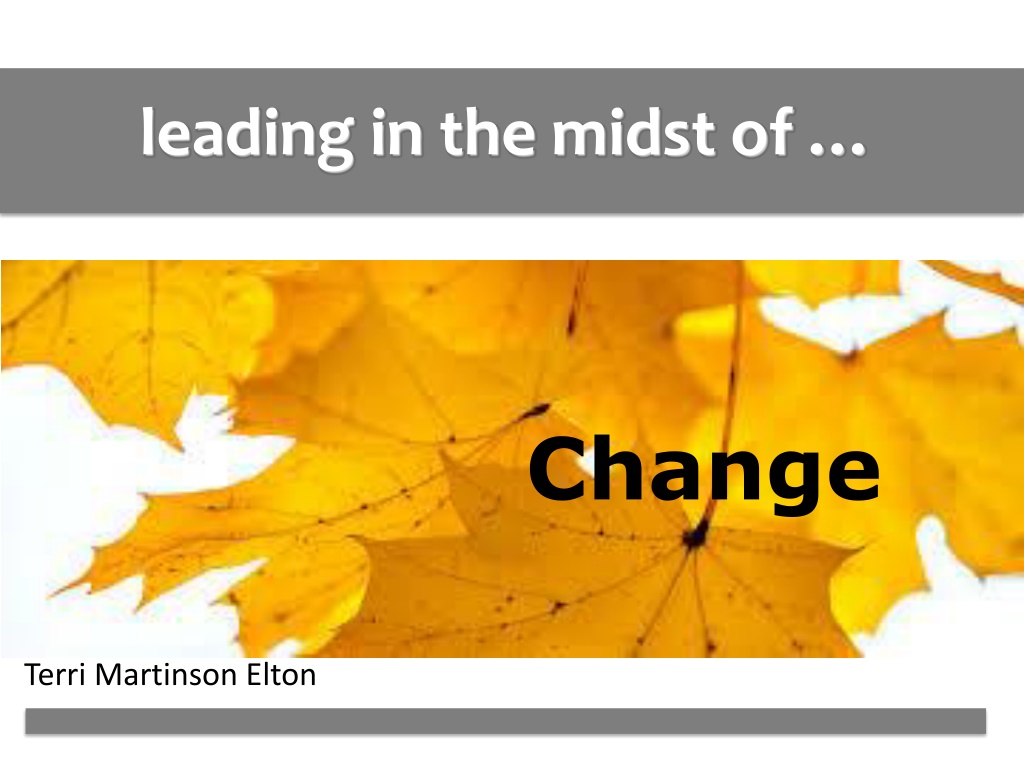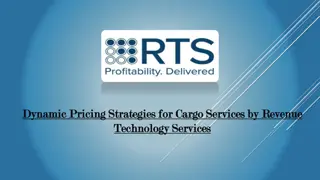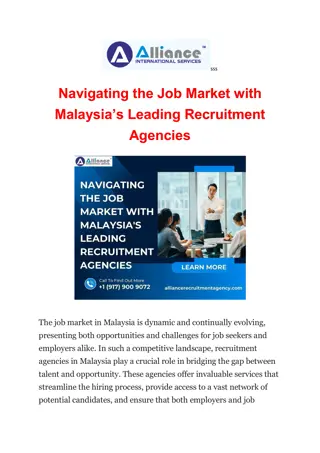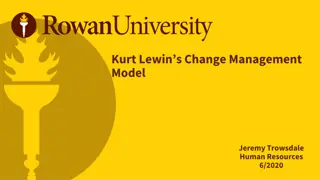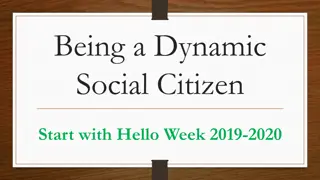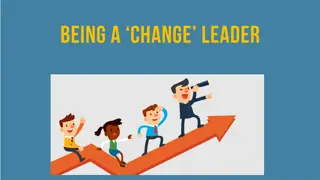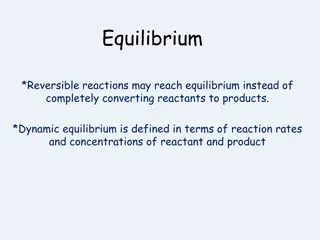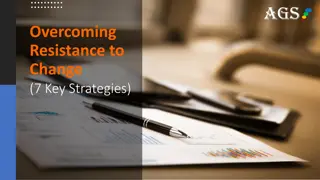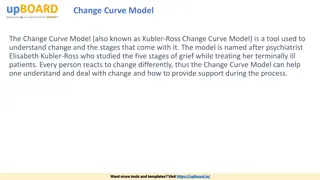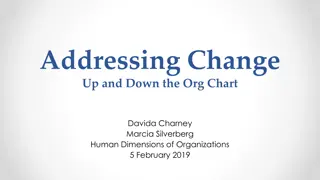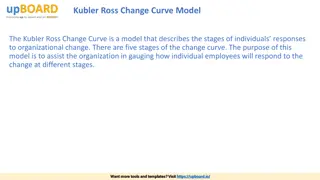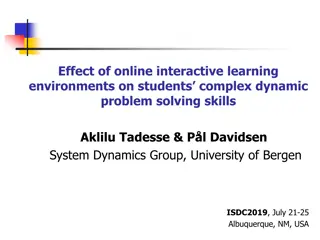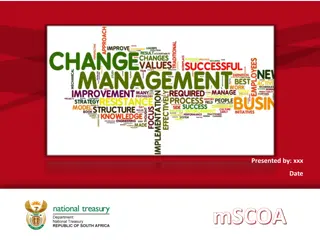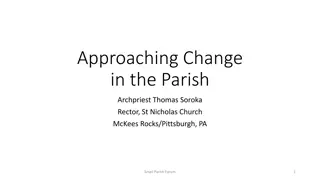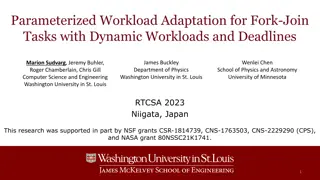Navigating Change: Strategies for Leading in Dynamic Environments
Explore different views of change, strategic approaches, and the importance of tending to both the process and decision-making aspects of change. Discover the significance of change theory and types of change, from continuous to paradigm shifts, in organizational leadership. Delve into the concepts of open and closed systems in the context of managing complexity.
Download Presentation

Please find below an Image/Link to download the presentation.
The content on the website is provided AS IS for your information and personal use only. It may not be sold, licensed, or shared on other websites without obtaining consent from the author. Download presentation by click this link. If you encounter any issues during the download, it is possible that the publisher has removed the file from their server.
E N D
Presentation Transcript
leading in the midst of Change Terri Martinson Elton
5 views of change Personal Descriptive Historical Systematic Strategic descriptive strategic historical personal systematic
Strategic What languages, relationships, strategies, and practices best accomplish the ministry and mission? What establishes the norms and strategies of concrete practices in light of the analysis of the concrete situation?
Strategic OR How do you tend to the culture (languages, relationships, strategies, and practices) in a way that aligns with your theological commitments while also leading God s people into God s future?
Change is both an event and a process! Hence tending to the process is as important as discerning the decision. Change is about the way we think and the way we act. Hence leading change is both about fostering certain behaviors and digging deeper into why we do things.
How can change theory help? How does it align with our theology?
All change is not the same! Name different types of change Continuous Discontinuous Transition Growth Adaptive Technical What theories have helped you lead these types of change? Conflict Individual Organizational Systemic Paradigm shifts ????
Closed systems Vs Open systems Has all it needs Needs the environment vs.
|degrees of open or closed| Open Kenneth Boulding, an economist, felt a need to create a general systems theory to allow disciplines to communicate. He also recognized the complexity of systems and developed a hierarchy. The higher up in the system the more able it is to deal with complexity. Transcendental Social Organizations Human Beings Animal System Plant System Cell Cybernetic device i.e. thermostat Clockwork Structural Framework General Systems Theory Kenneth Boulding, www.panachy.org/boulding/systems.1956.html Closed
|open systems| Inputs Those things that Influence and resource The organization Known or unknown, Wanted or unwanted Outputs The influences and resources the organization wants to put into the environment in order to carry out its mission and contribution to society. Information generated within an organization by the mere fact it s operating. Much information is lost, because people do not pay attention to it. But much can be gained from created feedback loops. Feedback Leading the Congregation by Norman Shawchuck and Roger Heuser. Pages 209 and 214.
Congregations are systems! Name some of the inputs. Name some of the outputs. What are some feedback loops?
|complex open systems| And congregations are made up of systems that operate within systems, all of which effect other systems. X X X X X X
|systems within larger systems| Organizational systems live within other systems! How do external systems impact congregational systems? Culture Social Structure Environment Physical Structure Technology Organization Mary Jo Hatch, Organization Theory: Modern, Symbolic, and Postmodern Perspectives, (New York: Oxford University Press, 1997) 15.
|voluntary systems| In addition to the being systems within larger systems, congregations have another component that makes them complex the fact that they are volunteer organization meaning they have to recruit their own resources for survival, including people, money, buildings, knowledge, etc. but they are also called, by their very nature, to be counter cultural from society.
|and counter-cultural systems!| Congregations are called to proclaim the gospel! Being disciples and apostles is counter-cultural!
|self-regulating| In organizations, we typically struggle against the environment, seeing it as the source of disruption and change. We tend to insulate ourselves from it as long as possible in an effort to preserve the precious stability we have acquired. Even though we know we need to be responsive to forces and demands beyond the boundaries of our organization, we still focus our efforts on maintaining the strongest defensive structure possible. We experience an inherent tension between stability and openness, a constant tug-a-war. But as I read about self-organizing systems, these dualities aren t present. Here are systems that stay strong by staying open. Wheatley, Leadership and the New Science, 82
|self-regulating| Self-organizing systems stay strong by being open! They have porous boundaries, are open to environment, and have a clear identity, which allows them to self-reference. Self-organizing systems partner WITH the environment while also creating autonomy from the environment.
|learning organization| According to Peter Senge learning organizations are: organizations where people continually expand their capacity to create the results they truly desire, where new and expansive patterns of thinking are nurtured, where collective aspiration is set free, and where people are continually learning to see the whole together.
|learning organization| The dimension that distinguishes learning from more traditional organizations is the mastery of certain basic disciplines or component technologies . The five disciplines are: Systems thinking Personal mastery Mental models Building shared vision Team learning
|lifecycle view| "Social institutions and movements have a natural life cycle that parallels our human development... Normally, one thinks in terms of 25-40 years for a neighborhood life cycle. Neighborhoods change because over time the demography, land use, economic and social networks of an area change. More often than not, the same changes that affect a neighborhood also affect the local churches which are a part of that neighborhood. Explorer #53, an e-publication of Leadership Network
|lifecycle view| Organizations are born, grow, age, and die. At each stage of development, certain challenges must be overcome is the organization is to survive and thrive. Thriving as an organization depends not only upon how it deals with its internal change, but also how the organization deals with the external change around it.
|lifecycle theory| Ichak Adizes, Managing Corporate Lifecycles Effectiveness Rendle, Gil, Leading Change in the Congregation: Spiritual and Organizational Tools for Leaders
Stage 1 Feeling Unsettled Stage 2 Denying/ Resisting Stage 3 Facing the Present Situation Stage 4 Letting Go into the Unknown Stage 5 Envisioning the Desired Future Stage 6 Exploring New Options Stage 7 Committing to Action Stage 8 Integrating the Change Allow myself to feel unsettled; admit dissatisfaction Recognize my resistance or denial for what it is Face my situation realistically; see what it is Grieve the issues associated with saying goodbye, including what I lost by hanging on too long Visualize what I want or how I want to be in the future Explorations of the new options I have envisioned for myself; experimenting with new behaviors Commit to action; choose the options that seem most appropriate Integrating the new quality/behavi or into the rest of my life so I operate at a higher level of complexity Task Ability to feel unpleasant feelings Ability to overcome or manage my fears Nonjudgment al, non- blaming attitude Ability to feel sadness, ability to tolerate uncertainty Ability to feel wants Ability to take risks Ability to make decisions and eliminate options Ability to feel and act on more than one impulse at a time Skills My attachment to always feeling fine or in control My denial or resistance Old picture of who I am or how things should be The need to know what I want and where I m going Safety of sticking with what is familiar Having to be good at everything Other alternatives; the need to keep all options open The sense of loss associated with choosing this instead of that Let Go I can handle pain/ discomfort I understand how my denial/resistan ce is an attempt to protect myself I can move ahead into the unknown without triggering more denial I can handle not knowing where I m heading or how things will turn out I trust that something new emerges out of the chaos I am open to new ways of being and doing things I can envision something new and make it a reality I can continue to learn and grow Learn Gil Rendle
|new science and systems| Margaret Wheatley s work Relationships Force fields Networks Nature is wired for life! We are wired for life!
|networks| In this organic time, patterns emerge and rules are being discovered. Gladwell offers three: law of a few stickiness factor power of context -Barabasi, Alberto-Laszlo, Linked: The New Science of Networks -Gladwell, Malcolm, The Tipping Point
|networks| - Nodes, hubs, and links are the components - Robustness is their protection against failure - Structural unevenness is key! Hub Hub Hub Hub Hub All is not created equally learning from scale-free networks.
|paradigm shifts| Thomas Kuhn spoke of paradigm shifts a time when things go back to zero. His work highlights that change is not always continuous!
|continuous change| Continuous change develops out of what has gone before and therefore can be expected, anticipated, and managed. The maturation of our children is an example. Generations have experienced this process of raising children and watching them develop into adults... (The Missional Leader, 7)
|continuous change| We can anticipate the stages and learn from those who have gone before us how to navigate the changes. We have a stock of experience and resources to address this development change; it is continuous with the experience of many others. This kind of change involves such things as improvement on what is already taking place and whether the change can be managed with existing skills and expertise. (The Missional Leader, 7)
|discontinuous change| Discontinuous change is disruptive and unanticipated; it creates situations that challenge our assumptions. The skills we have learned aren t helpful in this kind of change In discontinuous change: working harder with one s habitual skills and ways of working does not address the challenges being faced. An unpredictable environment means new skills are needed. There is no getting back to normal. (The Missional Leader, 7)
Discontinuous change is dominant in periods of history that transform a culture forever, tipping it over into something new. (The Missional Leader, 7)
Leading in times of discontinuous change requires new skills and ways of leading!
5 principles for leading transformational change Sooner or later the context changes to such a degree that the primary programs, resources, and skills that worked well in a long period of stability become a liability. We can t see all the steps along the way. We need new images and paradigms for leading where we can t predict outcomes. The natural world offers examples of organisms that adapt to discontinuous change. The key to such change is innovating an adaptive culture. Adaptive change happens by cultivating a culture. This involves the ability to create multiple experiments around the edge and then connect them with one another to form a co- learning environment. Cultivating such an environment requires new leadership skills and capacities. (The Missional Leader, 59-60)
|3 zone model of missional leadership| Emergent leadership Performative leadership Reactive leadership regulatory agency emergent organization choice crisis confusion new actions Transition leadership Building leadership Bridging leadership The Missional Leader, 41
putting the pieces together Forming mission environments and congregations: Member integration Missional culture Missional practices Cultivating people: Missional imagination Cultivates growth Enables change Creates coalitions Engaging context: Understanding society Member engagements Missional future Biblical foundation Personal foundation attributes self: Personal maturity Conflict management Personal courage Develops trust The Missional Leader, 114
|why?| Why lead change at all? No choice change is all around us. Discern what s the change we need to be tending? What s the point why are we, as Christian leaders, called to lead? And what are we called to lead?
Strategic Dimension How might engaging various theories help your community in the midst of change? What type of change is most prominent in your community right now? What theories have you used? How do they align with your theological commitments? What additional resources might be helpful? How do your current leadership and management practices support your vision for your community? How do they challenge it? What would it take to change some of those practices?
